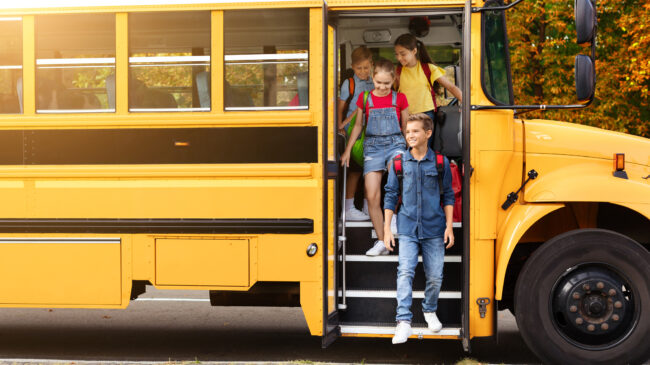Reason Foundation published a new report, Public Education at a Crossroads: A comprehensive look at K-12 resources and outcomes. The study reviews the latest national trends in public school spending, staffing, K-12 enrollment trends, and student outcomes, letting readers compare data from all 50 states since 2002.
Nationwide, public school spending increased from nearly $13,000 per student to more than $16,000 per pupil, inflation-adjusted, between 2002 and 2020. In fact, public school revenues increased in every state during that span, except North Carolina, where inflation-adjusted spending fell by 0.1% between 2002 and 2020.
Some states, such as New York and Illinois, significantly increased their per-pupil revenues. New York’s spending increased by 70% per student and Illinois per pupil revenues rose nearly 55% between 2002 and 2020. These spending increases are especially significant since public school enrollments declined by approximately 6% in both states during that time.
In some states, such as Illinois, these education revenue increases translated into higher National Assessment of Educational Progress (NAEP) outcomes for students, especially low-income students.
However, such results were not universal. In some states, large spending increases did not produce improved test scores. For instance, New York’s per-pupil revenues grew the most between 2002 and 2020, reaching a staggering $30,723 per pupil and outpacing Illinois’ by approximately $11,000 in 2020. Unfortunately, New York’s spending did not improve student outcomes. Despite having the highest total revenue per pupil of any state, New York’s fourth- and eighth-grade students’ NAEP outcomes in math and reading were largely flat.
On the other hand, some states made more modest investments in public education and produced improved outcomes. For example, Arizona, where public school enrollment increased by 25% between 2002 and 2020, only increased its total per-pupil spending by about 4%—or less than $500 per pupil. Even though Arizona’s total per-pupil education revenues were $10,790, a fraction of New York’s spending per student, the Grand Canyon State’s fourth and eighth graders saw impressive growth in their NAEP outcomes, significantly surpassing their peers from New York on all counts.
Table 1: 4th Grade NAEP Growth (2003-2019)
| NAEP Category | Arizona | New York |
| Math | 7 | 1 |
| Reading | 9 | -3 |
| FRL eligible math | 8 | 1 |
| FRL eligible reading | 9 | -1 |
Source: Reason Foundation.
Table 2: 8th Grade NAEP Growth (2003-2019)
| NAEP Category | Arizona | New York |
| Math | 4 | 1 |
| Reading | 9 | -4 |
| FRL eligible math | 8 | 4 |
| FRL eligible reading | 9 | 1 |
Source: Reason Foundation.
These seemingly contradictory funding and student outcome patterns could partially be explained by the fact that Arizona, unlike New York, uses competition to encourage schools to improve. Arizona’s various private school choice scholarship programs, combined with its robust charter and open enrollment sectors, mean that hundreds of thousands of students attend schools of their choosing.
Arizona’s public schools can’t afford to wait on policymakers to increase K-12 education funding since dissatisfied students can leave whenever they want. As a result, Arizona’s schools have been forced to do more with less while also succeeding in surpassing many of their peers’ NAEP growth in other states.
As federal COVID-related relief dollars dwindle, many states will be forced to tighten their financial belts. However, like Arizona, they can also produce high rates of student growth if they force schools to compete.
In fact, research from 27 studies reviewing private school choice programs in eight states and Washington, D.C. found that competition had either a positive, null to positive, or null effect on public school students. Notably, 20 of these studies found that competition had only positive effects on students in public schools, increasing student achievement. Only two studies showed that competition had no effect on students who remained in public schools. None of the 27 studies found that competition with private schools negatively impacted public school students.
Instead of assuming more spending will produce better results and burdening taxpayers with higher taxes to pay for increased education revenues, state policymakers should examine the states producing improved student outcomes and align their education systems’ fiscal incentives to foster competition. As Arizona’s data shows, for example, a competitive and student-centered education marketplace can help produce benefits for both school districts and students.
From the states
In other developments across the country, New Hampshire policymakers are considering expanding EFA eligibility, and Alabama policymakers introduced a major ESA proposal.
In New Hampshire, the House passed House Bill 1665, which would expand income eligibility for the state’s Education Freedom Accounts (EFA) to 500% of the federal poverty line. If signed into law, 70% of New Hampshire families could receive EFAs. The House also killed H.B. 1634 and H.B. 1561, which would have made all families in the Granite State eligible for an EFA. House Bill 1665 now goes to the state Senate.
The Alabama House passed the CHOOSE Act, which would provide a $7,000 education savings account (ESA) to students enrolled in accredited public and private schools participating in the program. Homeschooling families could receive an ESA valued at $2,000 per child (capped at $4,000 per family) to pay for eligible education expenses. These accounts would be funded through a new refundable income tax credit. Gov. Kay Ivey named this proposal her “number one legislative priority.”
The Missouri House passed House Bill 1989, sending it to the Senate. The proposal would establish a voluntary open enrollment program, allowing public school students to transfer to public schools other than their residentially assigned ones. While this proposal would definitely be a step in the right direction for students, it falls short of Reason Foundation’s best open enrollment practices primarily because not all school districts are required to participate.
Mississippi House Bill 1449 would establish Magnolia Scholarship Accounts which could pay for approved education expenses, such as private school tuition, tutoring, and books. The proposal aims to make all children eligible for an account within five years, funding each account at an “amount equal to one hundred percent (100%) of the average amount of the state share of per-student expenditure,” the Magnolia Tribune reported. Introduced by the House Education Committee chairman Rob Roberson with the support of the Speaker of the House Jason White, the bill will likely face opposition in the state senate.
In Tennessee, House Bill 1183 was approved by the House K-12 Education Subcommittee. This proposal would establish education savings accounts for 20,000 students, valued at $7,000.
What to watch
The Wisconsin Institute for Law and Liberty won its suit against the Wisconsin Department of Public Instruction (DPI) in a victory for school choice. A circuit court judge ruled Wisconsin could no longer reject school choice applications if parents’ legal records didn’t 100% match the information provided on the application. For instance, one application was rejected because a father signed his name as “Chuck” instead of “Charles.”
Nebraska’s tax-credit scholarship, the Opportunity Scholarship Act, will be challenged this fall through a statewide ballot initiative asking voters to approve scholarships that were in legislation passed in 2023. The scholarships, valued at $5,000 per pupil, could be used to pay for tuition and fees at private schools. Currently, 87% of students are eligible for a scholarship, although students who are low-income or bullied are prioritized in selection.
Recommended reading
Is It School Choice Or School’s Choice?
Mike McShane at Forbes
“First, public schools are not the open enrollment institutions that choice opponents cast them as. At a basic level, traditional public schools enroll students based on where they live. That discriminates against those students who cannot afford to live in their catchment area.”
Florida’s open-enrollment program is a popular and overlooked school choice success
Jude Schwalbach at Reason Foundation
“During the 2022-23 school year, more than 267,000 transfer students used Controlled Open Enrollment to transfer to schools inside their school districts but outside their attendance areas. Only 2%, or about 5,700 students, used COE to transfer to schools outside their school districts.”
Over 30 organizations vow to end ‘discriminatory’ public school district boundaries that ‘promote segregation’
Joshua Q. Nelson at Fox News
“Public school district boundary lines perpetuate ‘racial and economic divisions and prevent families from accessing the public school that best meets their children’s needs,’ the group argues. No More Lines Coalition added, ‘This issue is critical, as about 82% of American K-12 students attend public school today. Many states still have a policy in which a child attending any school is a criminal statute.’”

